Related Research Articles

Chapultepec, more commonly called the "Bosque de Chapultepec" in Mexico City, is one of the largest city parks in Mexico, measuring in total just over 686 hectares. Centered on a rock formation called Chapultepec Hill, one of the park's main functions is as an ecological space in Greater Mexico City. It is considered the first and most important of Mexico City's "lungs".
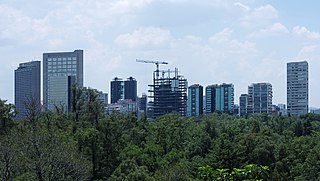
Miguel Hidalgo is a borough (alcaldía) in western Mexico City, it encompasses the historic areas of Tacuba, Chapultepec and Tacubaya along with a number of notable neighborhoods such as Polanco and Lomas de Chapultepec. With landmarks such as Chapultepec Park and the Museo Nacional de Antropología, it is the second most visited borough in Mexico City after Cuauhtémoc where the historic center of Mexico City is located. Tacubaya and Tacuba both have long histories as independent settlements and were designated as “Barrios Mágicos” by the city for tourism purposes.

Xochimilco is a borough of Mexico City. The borough is centered on the formerly independent city of Xochimilco, which was established on what was the southern shore of Lake Xochimilco in the precolonial period.

Tláhuac is a borough in the Mexico City, located in the southeastern edge of the entity. Though Tláhuac still contains rural communities within its borders, mostly in the southern and eastern portions, the borough has undergone a massive shift from urbanization, especially in its northwest. Tláhuac has experienced the fastest rate of population growth in Mexico City since the 1960s.

The Metropolitan Autonomous University also known as UAM, is a Mexican public university. Founded in 1974 with the support of then-President Luis Echeverria Alvarez, the institution aims to be closely linked to the social and human environment.

The Xochimilco Light Rail is a light rail line that serves the southern part of Mexico City. It connects to, but is not considered a part of, the Mexico City Metro. Rather, it is operated by the Servicio de Transportes Eléctricos (STE), the authority that operates Mexico City's electric trolleybus system and formerly operated the municipal electric tram system.
Nativitas is a station on Line 2 of the Mexico City Metro system. It is located in the Colonia Nativitas and Colonia Lago neighborhoods of Benito Juárez borough of Mexico City, directly south of the city centre on Calzada de Tlalpan. It is a surface station.

Vicente del Bosque González, 1st Marquess of Del Bosque is a Spanish retired football manager and former player. He is regarded as one of the greatest managers of all time and is to date the only football manager to have won the World Cup, the Champions League, the European Championship and the Intercontinental Cup.
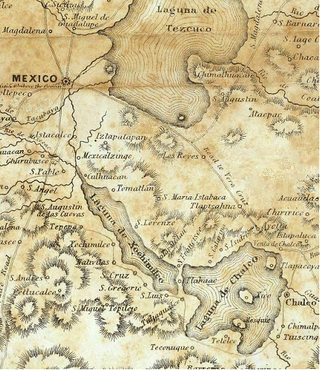
Lake Xochimilco is an ancient endorheic lake, located in the present-day Borough of Xochimilco in southern Mexico City. It is the last remaining habitat of the axolotl.

Colegio Alemán Alexander von Humboldt, A. C. is a network of German-language primary and secondary schools based in Greater Mexico City.
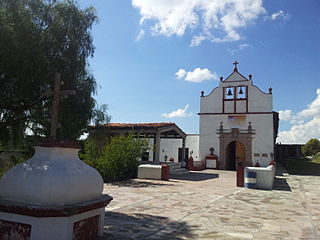
Aculco is a municipality located in the Atlacomulco Region of the State of Mexico in Mexico. The name comes from Nahuatl. The municipal seat is the town of Aculco de Espinoza, although both the town and municipality are commonly referred to as simply "San Jerónimo Aculco".
Under UNESCO’s Man and the Biosphere Programme, there are 125 biosphere reserves recognized as part of the World Network of Biosphere Reserves in Latin America and the Caribbean. These are distributed across 21 countries in the region.
Cumbres del Ajusco National Park is one of many national parks near Mexico City, DF. The Ajusco is known for its high elevations reaching 3,900 meters (12,795 ft) above sea level and is visible from any part of Mexico city. The park is characterized by pine-oak forests and high mountain grassland. Cumbres del Ajusco means "watered grove peaks", an appropriate name for this mountainous region covered with lush green forest with many flowers due to a fair amount of precipitation. The Balsas and Lerma rivers begin in the heart of the Cumbres del Ajusco.
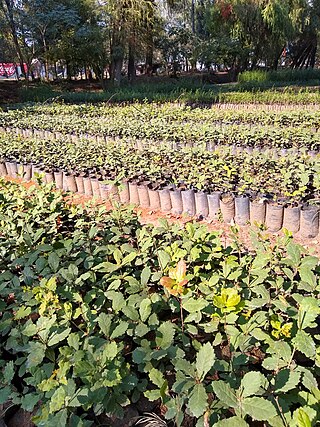
Viveros de Coyoacán is a combination tree nursery and public park which covers 38.9 hectares in the Coyoacán borough of Mexico City. The nursery was founded by Miguel Angel de Quevedo in the early 20th century as a way to provide seedlings for the reforestation of Mexico’s badly damaged forests, especially around Mexico City. The first lands were donated by Quevedo himself with the federal government then getting involved, allowing for the planting of 140,000 trees between 1913 and 1914 alone. Today, the nursery produces one million seedlings per year mostly for projects around Mexico City. The area was declared a national park in 1938 and today attracts between 2,500 and 3,000 visitors daily, many of whom come to exercise or feed the area’s very tame squirrels. The overpopulation of squirrels and a large rat population have been problems for the park.
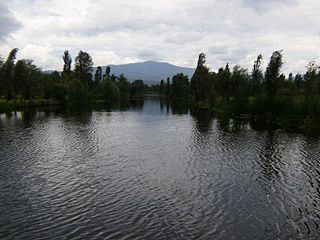
Xochimilco Ecological Park and Plant Market is a natural reserve or park, with a 13-hectare (32-acre) plant market, the largest in Latin America. The park and market are located in the southern Mexico City borough of Xochimilco, about 23 km south of the historic center of the city. The park was designed by Mario Schjetnan. The park was inaugurated in 1993, on chinampas which had been previously declared as part of a World Heritage Site. However, the area's ecology was badly degraded, and the park was established in order to revitalize and preserve the ecosystem. Success has been mixed. While much of the wetlands have been recharged, pollution and illegal settlements in the area remain as threats. As the park needs to be self-sustaining economically, there are a number of ways that the park raises money. One of the best known of these is the Xochimilco or Cuemanco Plant Market, which rents stalls to ornamental plant producers/sellers near the main entrance of the park.
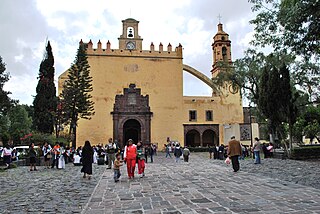
San Bernardino de Siena Church is the parish church of the borough of Xochimilco in Mexico City. The church and former monastery complex was built in the 16th century over a former pre-Hispanic temple as part of evangelization efforts after the Spanish conquest of the Aztec Empire. Since its construction, it has been the center of much of Xochimilco’s history and social life, including ceremonies related to is famous image of the Child Jesus called the Niñopa. The interior of the church contains a rare 16th-century altarpiece in Plateresque style with no columns or other supports. The only other altarpiece like it is in Huejotzingo, Puebla.
San Gregorio Atlapulco is a neighbourhood located in the borough of Xochimilco in Mexico City, Mexico.

The Sierra del Ajusco-Chichinauhtzin, also known as Serranía del Ajusco or Sierra de Chichinauhtzin, is a Mexican mountain range located between Mexico City and the states of Morelos and Mexico. It makes up the southern part of the mountain necklace that surrounds Mexico City. It is made up of more than one hundred volcanic cones, among which are: Tláloc, Chichinauhtzin (3,430 metres, Xitle (3,100 metres, Cerro Pelado (3,600 metres and Cuauhtzin (3,510 metres. Its maximum height is at the Cruz del Marqués peak on the Ajusco volcano.
Bosque Mesófilo Nevado de Colima State Park is a protected area in western Mexico. It is located in Jalisco state, and protects four cloud forests on the slopes of the twin volcanoes Nevado de Colima and Volcán de Colima.
References
- ↑ "Sitios para vacacionar in Xochimilco" (in Spanish). Archived from the original on 2009-07-27. Retrieved 2009-05-26.